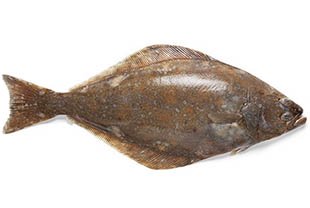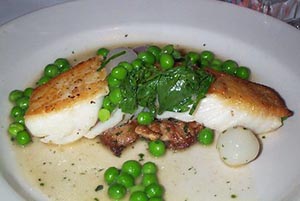Halibut Fish Nutrition facts
Halibut is a large, deep ocean flatfish well-known for its fine, firm, and delicious flaky meat. Halibut are bottom dwellers (demersal fish) inhabiting very cold, deep waters in the Pacific from Alaska to California, as well as in Atlantic waters off the coasts of Scotland, Norway, Iceland, and Newfoundland. They migrate to shallow waters for spawning.
Halibut fish belongs to the genus Hippoglossus, within the Pleuronectidae (flounders) family, also known as righteye flounders.
Common names for halibut include Giant halibut, righteye flounder, and barn doors, among others.
 |
| Atlantic halibut (H. hippoglossus). |
Description & habitat:
Halibut are large, saltwater flatfish that swim on their sides. Adults inhabit the deep ocean bed composed of sand and gravel, where they prey on small fish and crustaceans.
As halibut mature and adapt to their bottom-dwelling (demersal) habitat, their bodies develop asymmetrical features. They have a compressed body with an olive or gray-brown coloration on their right (upper) side and white on their left (under) side. Their large mouths are equipped with sharp, curved teeth, and both eyes are positioned on the same side of the head in adult fish, typically the right side (right-eyed) in most species.
Two species of halibut are:
Hippoglossus hippoglossus - Atlantic halibut, found in the North Atlantic.
Hippoglossus stenolepis - Pacific halibut, found in the North Pacific Ocean.
Atlantic halibut are notably larger and can reach enormous sizes, making them the largest of all flatfish. They typically measure between 20 and 55 inches in length and weigh between 11 and 55 pounds.
Health Benefits of Halibut fish
Halibut fish is among the finest sources of a href="essential-fatty-acids.html">essential fatty acids, protein, minerals, and fat-soluble vitamins such as vitamins A, E, and D.
It is a non-oily, deep-water fish and therefore low in calories and saturated fats; 100 grams contain just 91 calories, compared to 160 calories in salmon but higher than Dover sole (70 Cal/100 g).
Halibut contains lean, white meat that provides a good amino acid profile. A 100-gram serving of fish provides 18.56 grams of protein (33% of the Recommended Daily Intake). The protein composition is complete, containing all essential amino acids in healthy proportions.
Halibut's lean meat is a good source of polyunsaturated fatty acids (PUFA). Studies have shown that consuming seafood can decrease the risk of heart attack, stroke, obesity, and hypertension. Seafood is low in saturated fat and higher in "heart-healthy" polyunsaturated fat, including omega-3 fatty acids.
The US FDA categorizes halibut in the "good choice" section considering mercury levels in its flesh. The recommendation is to consume 1 serving (4 ounces) per week of halibut.
Halibut is a moderate source of omega-3 fatty acids, including eicosapentaenoic acid (EPA), docosapentaenoic acid (DPA), and docosahexaenoic acid (DHA). Research studies suggest that these fatty acids, particularly DHA, play an important role in the development of the nervous system, especially in infants and children.
According to Cornell University and the New York Sea Grant Extension Program in 2012, fatty acids play a crucial role in decreasing blood pressure and heart rate and help improve cardiovascular function. For example, research has shown that omega-3 fatty acids decrease the risk of arrhythmias (abnormal heartbeats) that can lead to sudden death.
In adults, several large trials have evaluated the effect of fish or fish oils on heart disease. In the GISSI Prevention Trial, heart attack survivors who took a 1-gram capsule of omega-3 fats every day for three years were less likely to have a repeat heart attack, stroke, or die of sudden death than those who took a placebo.
Being deep-water and non-oily fish, halibut contains small amounts of vitamin A (67 IU/100g). Nonetheless, it carries moderate amounts of omega-3 essential fatty acids such as ALA, DHA, and DPA to help maintain healthy mucosa and skin.
A 100-gram serving of halibut fillet contains 6.513 mg (41% RDA) of niacin and 0.548 mg (42% RDA) of pyridoxine (B-6). It is also a good source of vitamin E, vitamin B12, thiamin, and riboflavin.
Halibut fillet is a naturally rich source of minerals including iodine, calcium, zinc, potassium, phosphorus, and magnesium. Iodine is an important trace element in human nutrition and is essential for thyroid hormone synthesis.
| Principle | Nutrient Value | Percent of RDA |
|---|---|---|
| Energy | 91 Kcal | 4.50% |
| Carbohydrates | 0 g | 0% |
| Protein | 18.56 g | 33% |
| Total Fat | 1.33 g | 7% |
| Cholesterol | 49 mg | 25% |
| Dietary Fiber | 0 g | 0% |
| Vitamins | ||
| Folate total | 12 μg | 3% |
| Niacin | 6.513 mg | 41% |
| Pyridoxine | 0.548 mg | 42% |
| Riboflavin | 0.030 mg | 2% |
| Thiamin | 0.05 mg | 4% |
| Vitamin-A | 67 IU | 2.22% |
| Vitamin-C | 0.5 μg | <1% |
| Vitamin-D | 197 IU | 49% |
| Vitamin-E | 0.61 mg | 4% | Electrolytes |
| Sodium | 49 mg | 3.5% |
| Potassium | 361 mg | 7.7% |
| Minerals | ||
| Calcium | 7 mg | 0.7% |
| Copper | 0.023 mg | 2.50% |
| Iron | 0.16 mg | 2% |
| Magnesium | 23 mg | 6% |
| Phosphorus | 236 mg | 34% |
| Selenium | 45.6 mg | 83% |
| Zinc | 0.36 mg | 3% | Ω-3 Fatty acids |
| EPA (20:5 n-3) | 0.066 g | -- |
| DPA (22:5 n-3) | 0.016 g | -- |
| DHA (22:6 n-3) | 0.128 g | -- |
Buying
Halibut is a lean, white, firm, and flaky textured fish and contains very few bones. Fresh-caught halibuts are available from March to November. In the markets, large halibut are labeled as "barn doors," and small ones as "chickens."
They sold year-round as whole frozen (small chicken), steaks, or fileted. Look for white, moist, and glossy flesh. Buy steaks that cut from the middle-third, rather than the thin tail-end where the proportion of bone to the flesh is very high. Also, steaks from the tail end are liable to dry out more quickly while cooking than the mid-portion steaks.
Avoid halibut fish with a strong amine odor. Always store fillets/sections in the deep freezer.
Preparation
Halibut, a large oceanic flatfish, is commonly found in markets either as large sections or fillets, sometimes with the skin still attached. If you prefer it without the skin, simply peel it off inside out and remove any bones before cooking.
Halibut fish are highly sought after for their mild, sweet flavor and delicate texture. While fresh halibut appears almost translucent when raw, it transforms into an attractive snow-white color with a tender, flaky texture when cooked.
Due to its low oil content, halibut is best suited for poaching in white or red wine. Alternatively, it can be baked, grilled, or pan-roasted. It's important to avoid cooking methods that might cause the flesh to dry out.
Here are some serving ideas:
 |
| Poached halibut. Photo credit: stu_spivack |
Cook halibut in a simple, family-style casserole dish in the classic French style à la bonne femme with shallots, chanterellemushrooms, and cream.
Utilize fresh fillets in a seafood stew with complementary seafood such as clams, squids, and shrimps, along with vegetables, herbs, and spices like onions, garlic, parsley, tomato, and white wine for a delicious Italian stew (cioppino).
Braising or baking steaks and fillets with wine or stock is recommended to avoid drying.
Enjoy fresh raw halibut in ceviche with tomato and pineapple. Allow thin slices to marinate in lime juice and white tequila to help firm up the fish.
Halibut's thin, transparent slices and delicate earthy flavor are best suited for sashimi and sushi.
It can also be incorporated into chowder, mixed with vegetables such as baby potatoes, sugar peas, and pea tendrils. The halibut only needs a few minutes to cook in the flavorful broth.
Safety Profile
Mushy halibut syndrome is a non-harmful condition found in some catches of halibut fish, characterized by large areas of abnormally translucent and flaccid flesh. The entire musculature of the fish exhibits inferior meat quality, resulting in a jellylike consistency.
Although it doesn't pose any known human health concerns, halibut caught in the wild with this condition is typically discarded due to its aesthetically displeasing texture.
The mean methyl-mercury concentration in halibut fish is 0.241 ppm. Consequently, the U.S. FDA's final guidelines on how much fish expectant and breastfeeding mothers can safely consume, along with lists of specific options that are safe or should be avoided, categorize halibut as a good choice. According to these guidelines, they can consume 1 serving (4 ounces) of halibut per week. (Medical disclaimer).
Also read ≻≻-
≺≺- Mercury in Fish: Health Benefits, Risks, and Safe Choices
≻≻-Salmon nutrition facts and health benefits.
≻≻- Trout Fish nutrition facts and health benefits.
≻≻- Dover Sole nutrition facts and health benefits.
≻≻-Back to Seafood from Halibut fish nutrition facts and health benefits.
Further reading (Links opens in new window):
Atlantic Halibut (Hippoglossus hippoglossus) -Maine.gov. PDF.
Omega-3 Fatty Acids: An Essential Contribution.